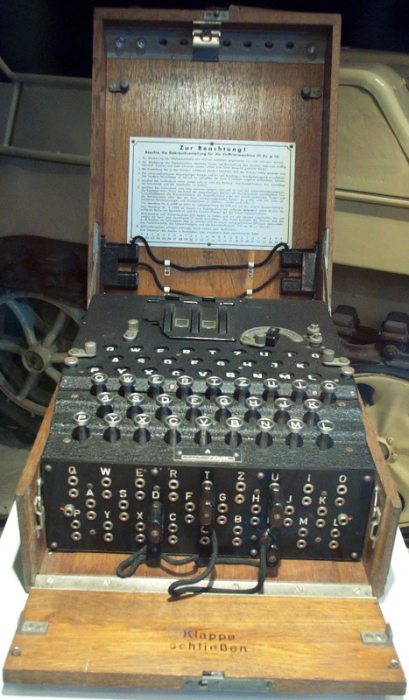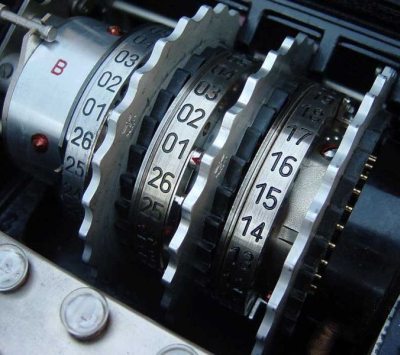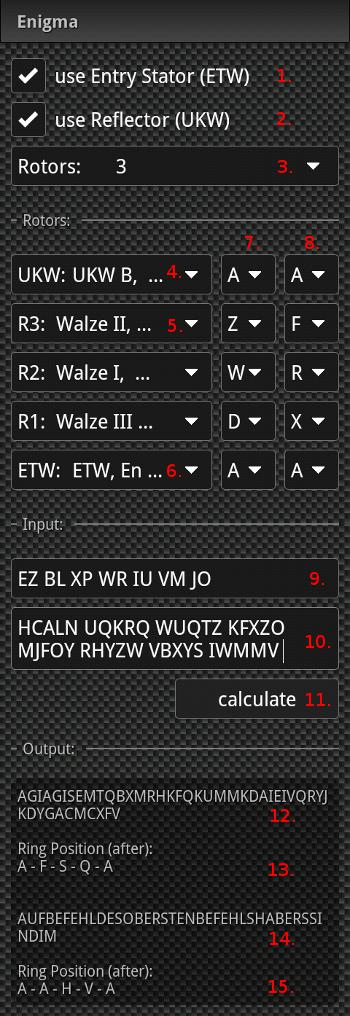| previous | Menu | next |
Enigma
Functionality and example

An Enigma machine (see Picture 1) is any of a family of related electro-mechanical rotor cipher machines used for the encryption and decryption of secret messages. The greek term Enigma means something puzzling, mysterious or inexplicable or riddle. Enigma was invented by German engineer Arthur Scherbius at the end of World War I.T he early models were used commercially from the early 1920s, and adopted by military and government services of several countries — most notably by N* Germany before and during World War II. Several different Enigma models were produced, but the German military models are the ones most commonly discussed. Far from being a single design, there are numerous models and variants of the Enigma family. Starting in the mid-1920s, the various branches of the German military began to use Enigma, making a number of changes in order to increase its security. In addition, a number of other nations either adopted or adapted the Enigma design for their own cipher machines. The most popular model was the ENIGMA I, being used by Reichswehr and also Wehrmacht.

The rotors (alternatively wheels) formed the heart of an Enigma machine. Each rotor was a disc approximately 3.9in in diameter made from hard rubber orbakelite with brass spring-loaded pins on one face arranged in a circle; on the other side are a corresponding number of circular electrical contacts. The pins and contacts represent the alphabet — typically the 26 letters A–Z. When the rotors were mounted side-by-side on the spindle, the pins of one rotor rest against the contacts of the neighbouring rotor, forming an electrical connection. Inside the body of the rotor, 26 wires connected each pin on one side to a contact on the other in a complex pattern. When a key is pressed, a circuit is completed with current flowing through the various components in their current configuration and ultimately lighting one of the display lamps, indicating the output letter. Most of the rotors were identified by Roman numerals and each issued copy of rotor I was wired identically to all others. The same was true of the special thin beta and gamma rotors used in the M4 naval variant.
Every key press caused one or more rotors to step by one twenty-sixth of a full rotation, before the electrical connections were made. This changed the substitution alphabet used for encryption, ensuring that the cryptographic substitution was different at each new rotor position, producing a more formidable polyalphabetic substitution cipher. When you entered e.g. "OTTO" the following bulbs would light subsequently: „PQWS“. The entry wheel, or entry stator, connects the plugboard, if present, or otherwise the keyboard and lampboard, to the rotor assembly. The plugboard was introduced on German Army versions in 1930, and was soon adopted by the Navy as well. It permitted variable wiring that could be reconfigured by the operator. A cable placed onto the plugboard connected letters up in pairs; for example, E and Q might be a steckered pair. The effect was to swap those letters before and after the main rotor scrambling unit. For example, when an operator presses E, the signal was diverted to Q before entering the rotors. Several such steckered pairs, up to 13, might be used at one time. The plugboard contributed a great deal to the strength of the machine's encryption. The reflector at the far left connected outputs of the last rotor in pairs, redirecting current back through the rotors by a different route. The reflector ensured that Enigma is self-reciprocal: conveniently, encryption was the same as decryption. The table shows the configuration of the five rotors and reflectors of the ENIGMA I:

Example of a genuine code:
The settings for that day were:
Wheel order: II I III,
Ring settings 26 (Z) 23 (W) 4 (D),
Plug settings (EZ) (BL) (XP) (WR) (IU) (VM) (JO),
Reflector B
The code read like this:
2109 - 1750 - 3 TLE - FRXFRX - 1TL - 75 =
HCALN UWBCG QLUWJ FCKLW MQIXW PDYVI EIRLY SDQRI ANEQQ QIZRW MIKFW NKZNG SVKZV VWXNB FNQDO
As can be seen in the message head, the message contains of three parts; the first part consists of 75 letters.
The message key reads FRXFRX, representing the starting position, typed twice. The first six digits of the message represent the sender's coded starting position. Upon setting the Enigma to FRX, the recipient decodes HCALNU into AGIAGI. The repition of AGI prooves that everything is correct.
With the rotors set to AGI, the decyphered message reads:
THIS IS AN EXAMPLE MESSAGE X BROUGHT TO YOU BY GCC X QEERS AND HAVE FUN WITH THE ENIGMA
It shows that punctuation marks were replaced with "X", as was the "CH" with "Q"
Operation

The above example illustrates how to use the GCC tool. All values and settings have already been inserted in the screenshot!
- Using the entry wheel - Although historically nearly always present, the entry wheel can be disabled in GCC
- Using a reflector - The first run of Enigma machines did not use reflector. In the example, reflector B has been set according to the day setting
- Number of rotors (excluding entry wheel and reflector) - Most Enigma models used 3 or 4 rotors. GCC, however, offers great flexibility - anything from 1 to 6 (different or same) rotors can be set up. The above example demands 3 rotors
- Which Reflector (if chosen) The example requires reflector B
- Which rotors? The leftmost rotor in the coding instructions is the topmost in GCC and so on The example requires 3 of them:("right to left" means "top to down") II, I, III
- Choice of entry wheel
- Ring setting, meaning setup of inner rings; reflector and entry wheel are normally unset and show A(1)) In the example, the current rotor setting is 26(Z), 23 (W) and 4 (D)
- Rotor Setting (outer rings)? - Dictated by the daily code.In the example: FRX
- Plug board - The pairs of of switched letters; input must be in pairs, separated by a space. Day code in the screenshot is EZ, BL, XP, WR, IU, VM and JO.
- Input Text to cipher or decipher
- The "Bazinga"-Button! :)
- Output of deciphered message (first run)
- Output of wheels and rotors AFTER decoding. After entering a single letter the rotors turn. That's wy they show specific outputs.
- Output of deciphered message (second run). This is the output of an automatic second decoding run. Messages have often been encrypted twice with a preceeding key to each message body (consisting of two identical letter triplets). If that's the case, GCC deciphers the mesage a second time.In the example the triplet AGI has been used
- Output of wheels and rotors AFTER a second decoding
Entry wheels (ETW):
| Name of Rotor | Alphabet |
|---|---|
| ETW, Enigma I 'Wehrmacht' | ABCDEFGHIJKLMNOPQRSTUVWXYZ |
| ETW, M4 'Shark' | ABCDEFGHIJKLMNOPQRSTUVWXYZ |
| ETW (T), Enigma T 'Tirpitz' | KZROUQHYAIGBLWVSTDXFPNMCJE |
| ETW (G), Enigma G 'Defense' | QWERTZUIOASDFGHJKPYXCVBNML |
| ETW (G), Enigma G312 'Defense' | QWERTZUIOASDFGHJKPYXCVBNML |
| ETW (G), Enigma G260 'Defense' | QWERTZUIOASDFGHJKPYXCVBNML |
| ETW, Enigma 'Reichsbahn' | QWERTZUIOASDFGHJKPYXCVBNML |
| ETW (D), Enigma D, Version 1 | JWULCMNOHPQZYXIRADKEGVBTSF |
| ETW (D), Enigma D, Version 2 | QWERTZUIOASDFGHJKPYXCVBNML |
| ETW, Enigma Swiss-K | QWERTZUIOASDFGHJKPYXCVBNML |
Reflectors (UKW):
| Name of Rotor | Alphabet |
|---|---|
| UKW A, M3 'Wehrmacht' | EJMZALYXVBWFCRQUONTSPIKHGD |
| UKW B, M3 and M4 'Wehrmacht' | YRUHQSLDPXNGOKMIEBFZCWVJAT |
| UKW C, M3 and M4 'Wehrmacht' | FVPJIAOYEDRZXWGCTKUQSBNMHL |
| UKW B 'thin', M4 'Shark' | ENKQAUYWJICOPBLMDXZVFTHRGS |
| UKW C 'thin', M4 'Shark' | RDOBJNTKVEHMLFCWZAXGYIPSUQ |
| UKW (T), Enigma T 'Tirpitz' | GEKPBTAUMOCNILJDXZYFHWVQSR |
| UKW (G), Enigma G 'Defense' | RULQMZJSYGOCETKWDAHNBXPVIF |
| UKW (G), Enigma G312 'Defense' | RULQMZJSYGOCETKWDAHNBXPVIF |
| UKW (G), Enigma G260 'Defense' | IMETCGFRAYSQBZXWLHKDVUPOJN |
| UKW, Enigma 'Reichsbahn' | QYHOGNECVPUZTFDJAXWMKISRBL |
| UKW (D), Enigma D | IMETCGFRAYSQBZXWLHKDVUPOJN |
| UKW, Enigma Swiss-K | IMETCGFRAYSQBZXWLHKDVUPOJN |
Rotors:
| Name of Rotor | Alphabet | Carry-over after |
|---|---|---|
| Rotor I, Enigma I 'Wehrmacht' | EKMFLGDQVZNTOWYHXUSPAIBRCJ | Q |
| Rotor II, Enigma I 'Wehrmacht' | AJDKSIRUXBLHWTMCQGZNPYFVOE | E |
| Rotor III, Enigma I 'Wehrmacht' | BDFHJLCPRTXVZNYEIWGAKMUSQO | V |
| Rotor IV, M3 'Wehrmacht' | ESOVPZJAYQUIRHXLNFTGKDCMWB | J |
| Rotor V, M3 'Wehrmacht' | VZBRGITYUPSDNHLXAWMJQOFECK | Z |
| Rotor VI, M3 and M4 'Wehrmacht' | JPGVOUMFYQBENHZRDKASXLICTW | Z, M |
| Rotor VII, M3 and M4 'Wehrmacht' | NZJHGRCXMYSWBOUFAIVLPEKQDT | Z, M |
| Rotor VIII, M3 and M4 'Wehrmacht' | FKQHTLXOCBJSPDZRAMEWNIUYGV | Z, M |
| Rotor Beta, M4 'Shark' | LEYJVCNIXWPBQMDRTAKZGFUHOS | fixed! |
| Rotor Gamma, M4 'Shark' | FSOKANUERHMBTIYCWLQPZXVGJD | fixed! |
| Rotor I (T), Enigma T 'Tirpitz' | KPTYUELOCVGRFQDANJMBSWHZXI | E, K, Q, W, Z |
| Rotor II (T), Enigma T 'Tirpitz' | UPHZLWEQMTDJXCAKSOIGVBYFNR | F, L, R, W, Z |
| Rotor III (T), Enigma T 'Tirpitz' | QUDLYRFEKONVZAXWHMGPJBSICT | E, K, Q, W, Z |
| Rotor IV (T), Enigma T 'Tirpitz' | CIWTBKXNRESPFLYDAGVHQUOJZM | F, L, R, W, Z |
| Rotor V (T), Enigma T 'Tirpitz' | UAXGISNJBVERDYLFZWTPCKOHMQ | C, F, K, R, Y |
| Rotor VI (T), Enigma T 'Tirpitz' | XFUZGALVHCNYSEWQTDMRBKPIOJ | E, I, M, Q, X |
| Rotor VII (T), Enigma T 'Tirpitz' | BJVFTXPLNAYOZIKWGDQERUCHSM | C, F, K, R, Y |
| Rotor VIII (T), Enigma T 'Tirpitz' | YMTPNZHWKODAJXELUQVGCBISFR | E, I, M, Q, X |
| Rotor I (G), Enigma G 'Defense' | DMTWSILRUYQNKFEJCAZBPGXOHV | A, B, C, E, F, G, I, K, L, O, P, Q, S, U, V, W, Z |
| Rotor II (G), Enigma G 'Defense' | HQZGPJTMOBLNCIFDYAWVEUSRKX | A, C, D, F, G, H, K, M, N, Q, S, T, V, Y, Z |
| Rotor III (G), Enigma G 'Defense' | UQNTLSZFMREHDPXKIBVYGJCWOA | A, E, F, H, K, M, N, R, U, W, X |
| Rotor I (G), Enigma G312 'Defense' | DMTWSILRUYQNKFEJCAZBPGXOHV | A, B, C, E, F, G, I, K, L, O, P, Q, S, U, V, W, Z |
| Rotor II (G), Enigma G312 'Defense' | HQZGPJTMOBLNCIFDYAWVEUSRKX | A, C, D, F, G, H, K, M, N, Q, S, T, V, Y, Z |
| Rotor III (G), Enigma G312 'Defense' | UQNTLSZFMREHDPXKIBVYGJCWOA | A, E, F, H, K, M, N, R, U, W, X |
| Rotor I (G), Enigma G260 'Defense' | RCSPBLKQAUMHWYTIFZVGOJNEXD | A, B, C, E, F, G, I, K, L, O, P, Q, S, U, V, W, Z |
| Rotor II (G), Enigma G260 'Defense' | WCMIBVPJXAROSGNDLZKEYHUFQT | A, C, D, F, G, H, K, M, N, Q, S, T, V, Y, Z |
| Rotor III (G), Enigma G260 'Defense' | FVDHZELSQMAXOKYIWPGCBUJTNR | A, E, F, H, K, M, N, R, U, W, X |
| Rotor I, Enigma 'Reichsbahn' | JGDQOXUSCAMIFRVTPNEWKBLZYH | N |
| Rotor II, Enigma 'Reichsbahn' | NTZPSFBOKMWRCJDIVLAEYUXHGQ | E |
| Rotor III, Enigma 'Reichsbahn' | JVIUBHTCDYAKEQZPOSGXNRMWFL | Y |
| Rotor I (D), Enigma D | LPGSZMHAEOQKVXRFYBUTNICJDW | Y |
| Rotor II (D), Enigma D | SLVGBTFXJQOHEWIRZYAMKPCNDU | E |
| Rotor III (D), Enigma D | CJGDPSHKTURAWZXFMYNQOBVLIE | N |
| Rotor I, Enigma Swiss-K | LPGSZMHAEOQKVXRFYBUTNICJDW | Y |
| Rotor II, Enigma Swiss-K | SLVGBTFXJQOHEWIRZYAMKPCNDU | E |
| Rotor III, Enigma Swiss-K | CJGDPSHKTURAWZXFMYNQOBVLIE | N |